Find the Solutions of the Exponential Equation
Previous Lesson Table of Contents Next Lesson
3-04 Solving Exponential and Logarithmic Equations
This is an original lesson based on OpenStax Precalculus lesson 4.6.
Summary: In this section, you will:
- Use one-to-one property to solve exponential equations.
- Use one-to-one property to solve logarithmic equations.
- Solve general exponential equations.
- Solve general logarithmic functions.

In John 6:1-15 and Matthew 1:13-21, the Bible tells the story of Jesus feeding the 5,000. Jesus went across the Sea of Galilee for some time with just his disciples, but the multitudes of people followed on land and quickly caught up with Him. So Jesus spent the day teaching and healing. Near evening, Jesus asked where to buy food for the 5,000 men plus women and children. The crowd has been estimated at 15,000 people. A boy had a lunch of five small barley loaves adn two small fish. Jesus took the food, gave thanks, and broke the bread and fish. Then he passed out the pieces of bread and fish to the desciples to give to the people. If the bread and fish were each divided in half, how many time would it have to be divided to feed all 15,000 people?
This can be modeled by pieces = 7(2) t . If each person got one piece of food, the equation becomes 15,000 = 7(2) t . The lesson today is on how to solve these types of problems.
Solving By Graphing
To solve any equation by graphing, follow the general procedure from last chapter.
Solve by Graphing
- Move everything to one side of the equation so that the other side is 0.
- Graph the expression.
- Find the x-intercepts. These are the solutions.
This process will be demonstrated in the following examples.
Solving Exponential Equations
Method 1: One-to-One Property
Exponential functions have a one-to-one property which means each input, x, value gives one unique output, y, value. Each x gives only one y, and each y gives only one x. This means exponential equations have only one solution.
Solve Exponential Equations using One-to-One Property
To solve an exponential equation using the one-to-one property.
- Rewrite both sides of the equation as an exponential expression with the same base. If this cannot be done, use method 2.
- Since the bases are equal, then the exponents must be equal. Set the exponents equal to each other and solve.
- Check your solution.
Example 1 Solve an Exponential Equation using the One-to-One Property
Solve 3 x + 2 = 27 x .
Solution
Rewrite both sides of the equation as exponential functions with the same base. The right side is 27 which can be written as 33 using base 3 like the left side of the equation is.
3 x + 2 = (33) x
3 x + 2 = 33x
Since the bases are equal, then the exponents must also be equal. So rewrite an equation using the exponents. Then solve the equation.
x + 2 = 3x
2 = 2x
1 = x
Notice that when you check the answer by plugging in 1 for x, both sides equal 27. Thus 1 is a good solution.
Analysis
To solve this by graphing, subtract the 27 x to make the right side 0.
3 x + 2 − 27 x = 0
Graph the left-hand side and find the x-intercept.
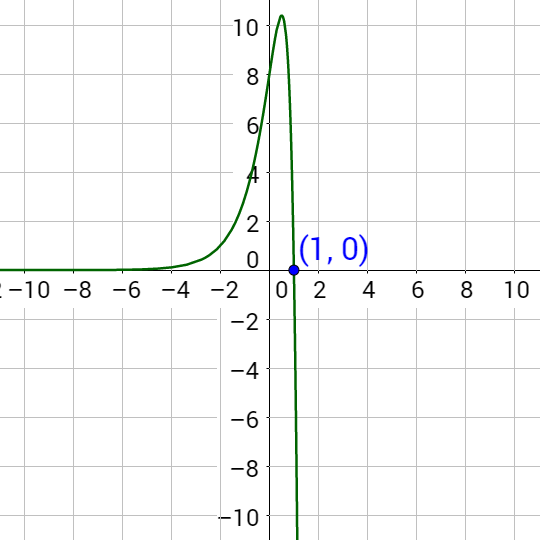
Since the x-intercept is (1, 0), the solution is x = 1.
Try It 1
Solve 4 x − 1 = 16.
Answer
x = 3
Method 2: Take the Logarithm of Both Sides
Method 1 only works when both sides of the equation can easily be written as exponential expressions with the same base. If this cannot be done, more traditional methods of solving must be used. To solve any equation, inverses of the operations are used to get the variable alone. To undo multiplication, divide; to undo squaring, square root; to undo exponential, logarithm. So to solve an exponential equation use the inverse, a logarithm. This has the same effect as rewriting the exponential equation as a logarithm.
Solve an Exponential Equation by Taking Logarithms of Both Sides
To solve an exponential equation using logarithms
- Isolate the exponential expression.
- Take a logarithm of both sides. The base does not really matter as log as it is the same on both sides, but usually using the base of the exponential expression is easiest.
- Rewrite the exponential side as a linear expression.
- Solve the resulting equation.
- Check your solution.
Example 2 Solve an Exponential Equation
Solve 5 x + 2 = 17.
Solution
Notice the exponential expression, 5 x + 2 is already isolated. So now take the log base 5 of both sides since the base of the exponential is 5.
5 x + 2 = 17
log5 5 x + 2 = log5 17
The properties of logarithms say that the log base 5 and the base 5 of the exponential cancel because they are inverses.
log5 5 x + 2 = log5 17
x + 2 = log5 17
x = (log5 17) − 2
x ≈ −0.240
Plug −0.240 into the original equation and see that both sides approximate 17, so it is the correct solution.
Analysis
To solve this by graphing, subtract the 17 to make the right side 0.
5 x + 2 − 17 = 0
Graph the left-hand side and find the x-intercept.
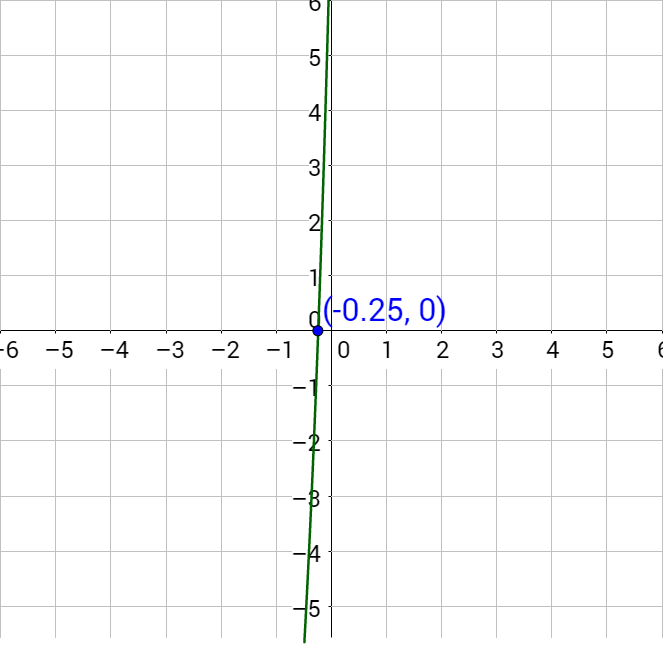
Since the x-intercept is (−0.240, 0), the solution is x = −0.240.
Example 3 Solve an Exponential Equation
Solve 2e x + 1 − 4 = 12.
Solution
Start by isolating the exponential expression.
2e x + 1 − 4 = 12
2e x + 1 = 16
e x + 1 = 8
Take the logarithm of each side. Since the base of the exponential is e, use log base e.
ln e x + 1 = ln 8
The ln and base e cancel.
ln e x + 1 = ln 8
x + 1 = ln 8
x = (ln 8) − 1
x ≈ 1.079
Plug 1.079 into the original equation and see that both sides approximate 12, so it is the correct solution.
Analysis
To solve this by graphing, subtract the 12 to make the right side 0.
2e x + 1 − 16 = 0
Graph the left-hand side and find the x-intercept.
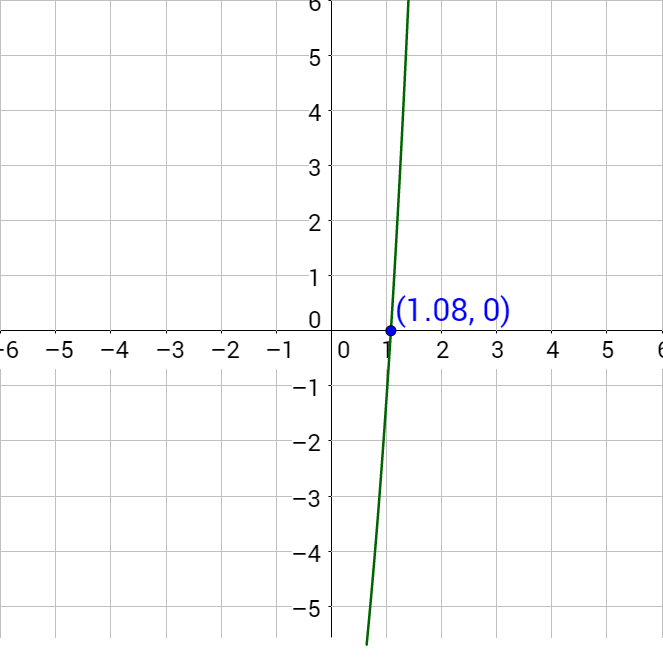
Since the x-intercept is (1.079, 0), the solution is x = 1.079.
Try It 2
Solve 3(2) x = 12.
Solution
x = 2
Solve Logarithmic Equations
Method 1: One-to-One Property
Since exponential functions are one-to-one, their inverses are also one-to-one. Logarithms are the inverse of exponential functions, so logarithmic functions are one-to-one.
Solve a Logarithmic Equation using the One-to-One Property
To solve a logarithmic equation using the one-to-one property
- Make sure both sides of the equation are logarithms with the same base. No other terms other than the logarithm can be in the equation.
- Notice that since the logarithm bases are equal, then the expressions in the logarithms are equal. Write a new equation.
- Solve the new equation.
- Check the solution, it is possible obtain extraneous solutions.
Example 4 Solve a Logarithmic Equation using the One-to-One Property
Solve log3 (x + 1) = log3 (2x).
Solution
Each side of the equation is a logarithm with the same base, so the expressions in the logarithms are also equal.
log3 (x + 1) = log3 (2x)
x + 1 = 2x
1 = x
Check the solution by plugging 1 into the original equation. Both sides become log3 2, so it is the correct solution.
Analysis
To solve this by graphing, subtract the log3 (2x) to make the right side 0.
log3 (x + 1) − log3 (2x) = 0
Graph the left-hand side and find the x-intercept.
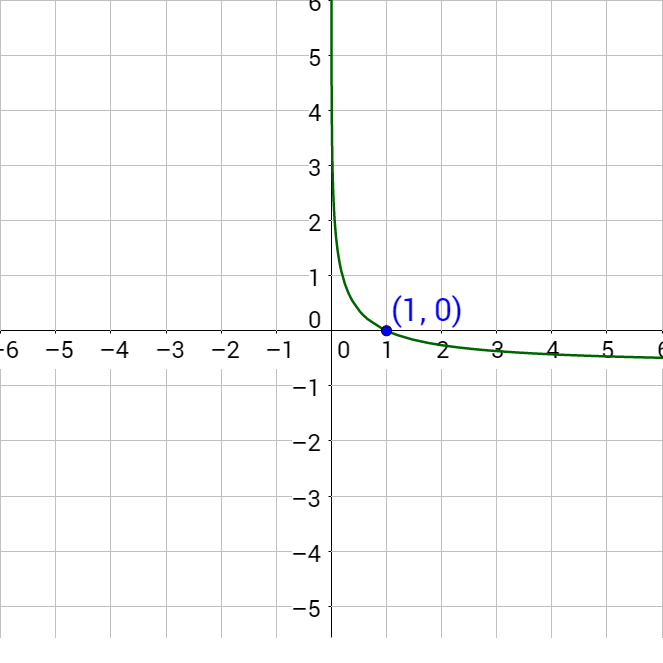
Since the x-intercept is (1, 0), the solution is x = 1.
Try It 3
Solve log4 x = log4 (3x − 7).
Answer
x = 7⁄2
Method 2: Exponentiate Both Sides
When the equation does not have a single logarithm on both sides of the equation, you need to use the general method of taking the inverse. The inverse of a logarithm is an exponential. To solve a general logarithmic function, make both sides the exponent of an exponential function using the base of the logarithm as the base of the exponential.
Solve a Logarithmic Equation by Exponentiating Both Sides
To solve a general logarithmic equation
- Isolate the logarithmic expression.
- Exponentiate both sides of the equation using the base of the logarithm. Do this by the expression on each side of the equation becomes the exponent with the base of the logarithm as the base of the exponential.
- Simplify the expressions on each side of the equation.
- Solve the resulting equation.
- Check your solution, it is possible to get extraneous solutions.
Example 5 Solve a Logarithmic Equation
Solve log3 (2x − 3) = 1.5.
Solution
The logarithm is already isolated, so start by exponentiating both sides. Use 3 as the base.
log3 (2x − 3) = 1.5
3log3 (2x − 3) = 31.5
Using the properties of logarithms, or the fact that logarithms and exponentials are inverses, the base 3 and log base 3 cancel. Then solve the resulting equation.
3log3 (2x − 3) = 31.5
2x − 3 = 31.5 ≈ 5.196
2x = 31.5 + 3 ≈ 8.196
x ≈ 4.098
Check the solution by plugging the answer into the original equation. Both sides approximate 1.5, so 4.098 is the solution.
Analysis
To solve this by graphing, subtract the log3 (2x) to make the right side 0.
log3 (2x − 3) − 1.5 = 0
Graph the left-hand side and find the x-intercept.
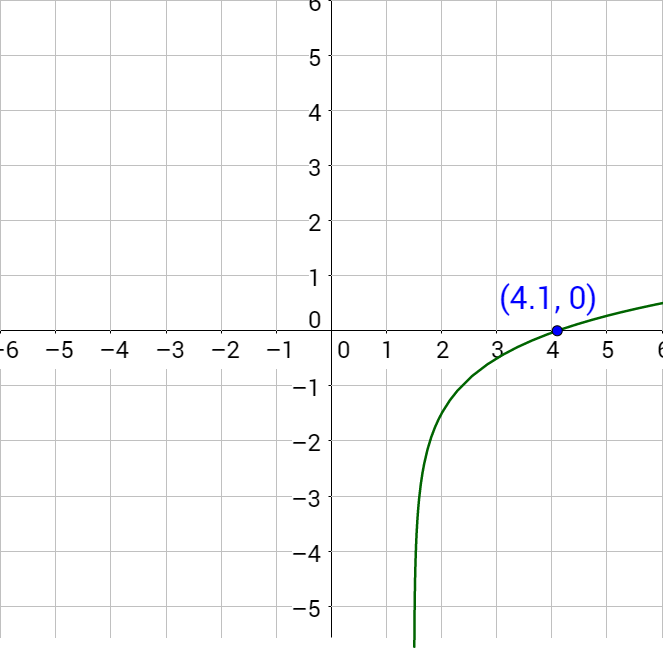
Since the x-intercept is (4.098, 0), the solution is x = 4.098.
Example 6 Solve a Logarithmic Equation
Solve log2 (x − 2) + log2 (x) = 3.
Solution
The first step is to isolate the logarithm, but there are two of them. Condense the logarithms to make a single logarithm that is isolated on the left side of the equation.
log2 (x − 2) + log2 (x) = 3
log2 ((x − 2)(x)) = 3
log2 (x 2 − 2x) = 3
The base of the logarithm is 2, so exponentiate both sides using 2 as the base. Then simplify and solve the resulting equation.
2log2 (x 2 − 2x) = 23
2log2 (x 2 − 2x) = 8
x 2 − 2x = 8
x 2 − 2x − 8 = 0
(x − 4)(x + 2) = 0
x − 4 = 0 and x + 2 = 0
x = 4 and x = −2
Check the solutions.
- 4: log2 (4 − 2) + log2 4 = 3
log2 2 + log2 4 = 3
1 + 2 = 3
This is true, so 4 is a solution. - −2: log2 (−2 − 2) + log2 −2 = 3
log2 (−4) + log2 (−2) = 3
Logarithms of negative numbers are undefined, so −2 is an extraneous solution and not a valid answer.
The solution is x = 4.
Analysis
To solve this by graphing, subtract the 3 to make the right side 0.
log2 (x − 2) + log2 (x) − 3 = 0
Graph the left-hand side and find the x-intercept.
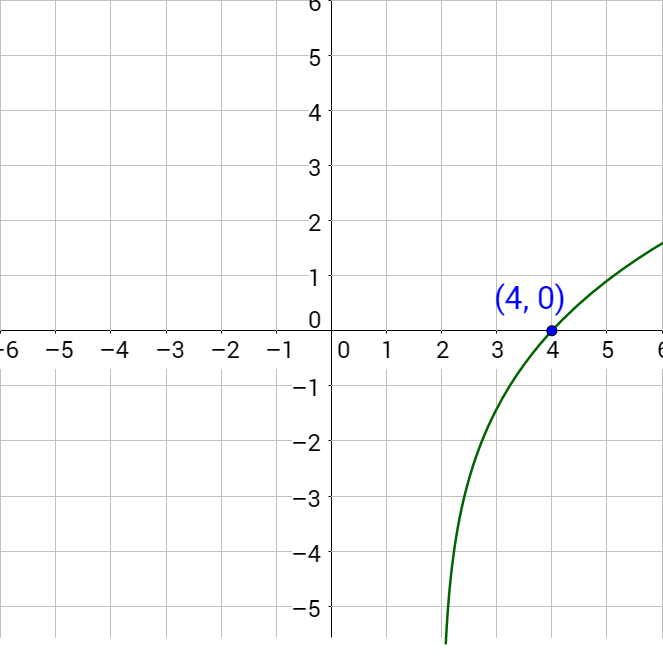
Since the x-intercept is (4, 0), the solution is x = 4.
Try It 4
Solve log3 (2x) = log3 (x) + 4.
Answer
x = 81
Example 7 Solve a Real Life Problem
During the Feeding of the 5,000, Jesus broke 5 loaves and 2 small fish and passed the pieces to the disciples who in turn passed them to the people. If each time the bread and fish were broken, Jesus broke them into two pieces each and there were 15,000 people, (a) write a model for the number of pieces of bread, P, after x number of breakings. Then (b) how many times did Jesus have to break a piece of bread before each person could have at least 1 piece?
Solution
-
Since the bread was always broken into two pieces, the amount of bread would always be multiplied by two. This is an exponential model with base 2. This gives the begin of the model.
P = 2 x
However, at x = 0, or before any bread was broken, this model gives P = 20 = 1. But this should be 5 since there were originally 5 loaves, so multiply the model by 5.
P = 5(2) x
-
Since there were 15,000 people, then there will need to be 15,000 pieces of bread if each person is to get just one piece. So, P = 15,000 and solve for x.
15,000 = 5(2) x
Isolate the exponential expression by dividing by 5.
3,000 = 2 x
Because this is a general exponential equation, solve it by taking the logarithm of each side. Choose base 2 since that is the base of the exponential.
log2 3,000 = log2 2 x
log2 3,000 =log2 2x
log2 3,000 = x
x ≈ 11.55Since the bread cannot be only half broken, the answer needs to be rounded up. Jesus would of had to break the bread about 12 times for each person to get just one piece. However, everyone got more than one piece. They got as much as they wanted with 12 big baskets of food left over. That means there was a lot of breaking of food happening, or maybe the miracle was done some other way.
Practice Exercises
- When can the one-to-one property of logarithms be used to solve an equation? When can it not be used? (4.6#3)
- 43x = 16 (RW)
- 3 x − 4 = 81 x (RW)
- 9x − 10 = 1 (4.6#11)
- −8 ⋅ 10 p + 7 − 7 = −24 (4.6#15)
- −6e 9x + 8 + 2 = −74 (4.6#19)
- log13 (5n − 2) = log13 (8 − 5n) (4.6#37)
- ln(−3x) = ln(x 2 − 6x) (4.6#39)
- 5 log7 (n) = 10 (4.6#31)
- 4 + log2 (9k) = 2 (4.6#33)
- 10 − 4 ln (9 − 8x) = 6 (4.6#35)
- log9 (x) − 5 = −4 (4.6#51)
- log(4) + log(−5x) = 2 (4.6#55)
- log11 (−2x 2 − 7x) = log11 (x − 2) (4.6#59)
- The population of a small town is modeled by the equation P = 1650e 0.5t where t is measured in years. In approximately how many years will the town's population reach 20,000? (4.6#67)
- (3-03) Condense ln 2 − ln x − ln y (RW)
- (3-03) State the asymptote, domain, range, and then graph f(x) = log3 (x) + 2 (RW)
- (3-02) Rewrite in logarithmic form: 3 x + 1 = y (RW)
- (3-01) Frank invests $20 in an account that pays 5% interest. How much is the account worth after 15 years if the interest is compouneded (RW)
- monthly?
- daily?
- continuously?
- (3-01) State the asymptote, domain, range, and then graph g(x) = 2e x − 1 (RW)
Solve using the one-to-one property.
Use logarithms to solve.
Use the one-to-one property of logarithms to solve.
Solve the equation.
Solve the equation for x by graphing.
Real Life Problems
Mixed Review
Answers
- The one-to-one property can be used if both sides of the equation can be rewritten as a single logarithm with the same base. If so, the arguments can be set equal to each other, and the resulting equation can be solved algebraically. The one-to-one property cannot be used when each side of the equation cannot be rewritten as a single logarithm with the same base.
- ⅔
- −4⁄3
- 10
- −6.673
- −0.607
- 1
- No solution
- 49
- 1⁄36
- 0.785
- 9;
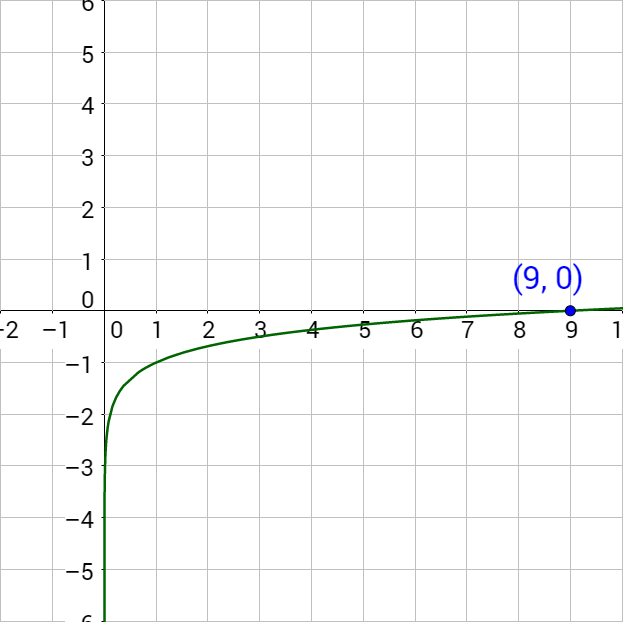
- −5;
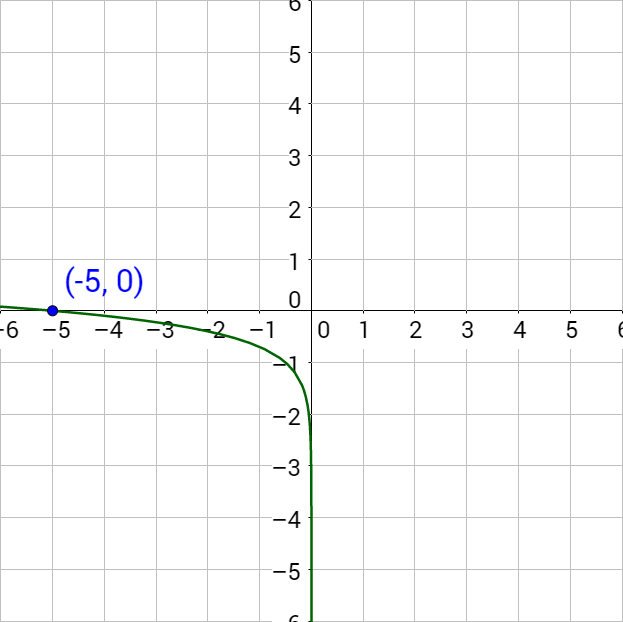
- No solution;
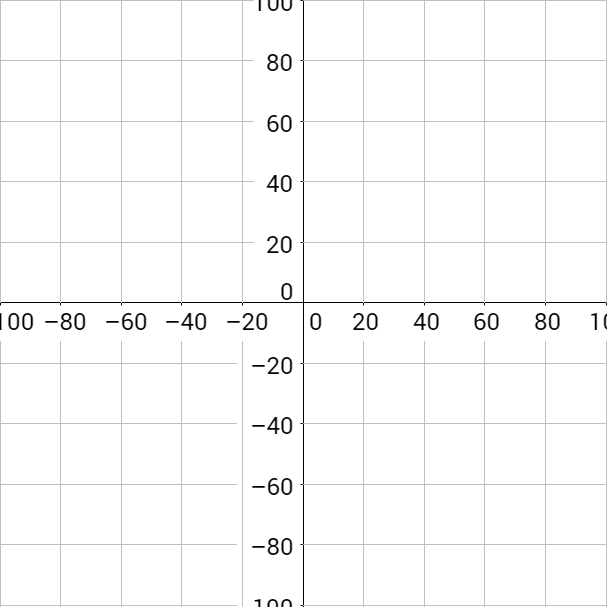
- About 5 years
- VA: x = 0; Domain: (0, ∞); Range: (−∞, ∞);
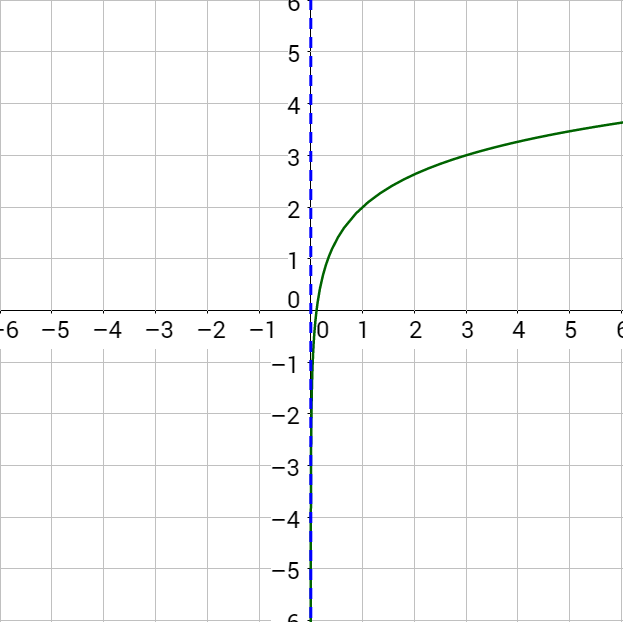
- log3 y = x + 1
- $42.27; $42.34; $42.34
- HA: y = 0; Domain: (−∞, ∞); Range: (0, ∞);
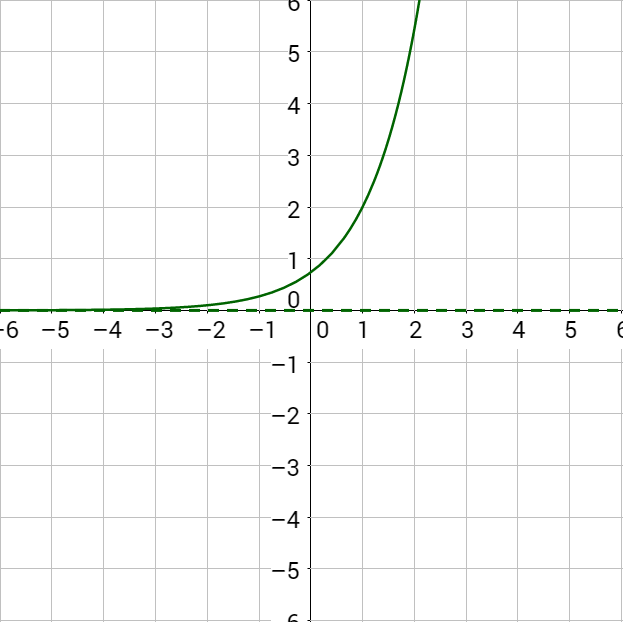
Find the Solutions of the Exponential Equation
Source: https://www.andrews.edu/~rwright/Precalculus-RLW/Text/03-04.html